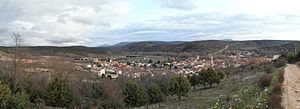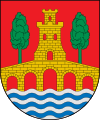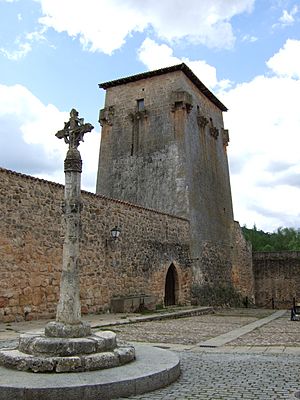Covarrubias, Spain facts for kids
Quick facts for kids
Covarrubias
|
|||||||||||||||
|---|---|---|---|---|---|---|---|---|---|---|---|---|---|---|---|
|
Municipality and town
|
|||||||||||||||

Panoramic view of Covarrubias, 2010
|
|||||||||||||||
|
|||||||||||||||

Location of Covarrubias
|
|||||||||||||||
| Country | Spain | ||||||||||||||
| Autonomous community | |||||||||||||||
| Province | |||||||||||||||
| Comarca | Arlanza | ||||||||||||||
| Area | |||||||||||||||
| • Total | 41.07 km2 (15.86 sq mi) | ||||||||||||||
| Elevation | 894 m (2,933 ft) | ||||||||||||||
| Population
(2018)
|
|||||||||||||||
| • Total | 545 | ||||||||||||||
| • Density | 13.270/km2 (34.37/sq mi) | ||||||||||||||
| Time zone | UTC+1 (CET) | ||||||||||||||
| • Summer (DST) | UTC+2 (CEST) | ||||||||||||||
| Postal code |
09346
|
||||||||||||||
| Website | http://www.covarrubias.es/ | ||||||||||||||
|
|||||||||||||||
Covarrubias is a charming village and a municipality located in the Burgos province of Spain. It's part of the Castile and León region, which is one of Spain's autonomous communities. This means it has its own local government.
The village is home to about 545 people (as of 2018). It's surrounded by other small towns like Mecerreyes and Hortigüela. Covarrubias sits in the beautiful valley of the river Arlanza. This area is full of trees, including a special kind called Spanish Juniper. Some parts of the municipality are even protected as a Special Protection Area for birds, like vultures.
In 1965, Covarrubias was recognized as a Conjunto Histórico-Artístico. This is a special title given to places that are important for their history and art. It helps protect the village's unique character. Covarrubias also has a special friendship with Tønsberg in Norway. This connection goes back to the Middle Ages because of a Norwegian princess named Christina of Norway, Infanta of Castile. In 2011, a church honoring Saint Olaf II of Norway was built in the town.
Covarrubias was first established a very long time ago, in the 7th century AD, by a Visigoth king named Chindasuinth. It was one of the first places to be taken back from the Moors in the late 800s during the Reconquista. This village played an important role in the history of Castile and the development of the Spanish language.
The local river is a great spot for swimming and canoeing. About 6 kilometers away, you can find a cool natural spring called Fuente Azul, located in the municipality of Hortigüela. Covarrubias has a pleasant climate. Its local food specialties include black pudding, grapes used for wine, and delicious cherries.
Contents
What to See in Covarrubias
Covarrubias is full of interesting historical buildings and sites.
The Torreón
This is a very old tower, often called the Torreón of Fernán González of Castile. It's a strong, historic structure that stands out in the village.
The Collegiate Church
The Colegiata is a large, beautiful Gothic church. It's a designated monument, meaning it's officially protected for its historical value. Inside, you can find an old organ and a museum. The museum even has a painting that some believe was created by the famous artist Van Eyck.
Princess Christina's Tomb
A special part of the collegiate church is the tomb of Princess Christina of Norway. She traveled from Norway to Spain in 1257 and was buried here. Her tomb is a key part of the village's history and its connection to Norway.
Friendship with Tønsberg, Norway
Covarrubias has a special friendship, or twinning, with the city of Tønsberg in Norway. This unique connection is because of Princess Christina of Norway. She journeyed from Tønsberg to Spain in 1257 and was laid to rest in Covarrubias. This historical link keeps the two places connected today.
See also
 In Spanish: Covarrubias para niños
In Spanish: Covarrubias para niños





